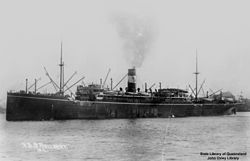Ballarat (ship)
|
||||||||||||||||||||
|
||||||||||||||||||||
|
||||||||||||||||||||
|
||||||||||||||||||||
|
||||||||||||||||||||
The Ballarat (II) was a 1911 commissioned passenger ship of the British shipping company Peninsular and Oriental Steam Navigation Company (P&O), which was used in the emigrant traffic from Great Britain to Australia . During the First World War , the Ballarat served as a troop transport until it was torpedoed by a German submarine on April 25, 1917 off the Isles of Scilly and sank the next day.
The ship
In 1910 P&O bought the shares in the British shipping company Blue Anchor Line (London), which had not recovered from the loss of its passenger ship Waratah the year before. The Australian service of the Blue Anchor Line was taken over and renamed P&O Branch Line. The Caird & Company shipyard in Greenock , Scotland , immediately placed orders for five new sister ships for the new emigrant traffic to Australia. The 11,120 GRT Ballarat was the first of these five ships to be completed in 1911 . It was followed by the Beltana (11,120 GRT) in 1912 , the Benalla (11,118 GRT) and the Berrima (11,137 GRT) in 1913 and the Borda (11,136 GRT) in 1914 .
The 150-foot-long, steel-built steamship Ballarat had a chimney, two masts and two propellers and was powered by two quadruple expansion steam engines that developed 9,000 PSi and allowed a speed of 16.5 knots. The ship had space for 490 third class passengers. Since the Ballarat was only supposed to carry emigrants, there was no first or second class. The ship was launched at Caird & Company on September 23, 1911 and was christened by Mrs. FC Allen, wife of the managing director of the P&O Branch Line.
The ship was registered on November 1, 1911. The Ballarat chimney was initially painted in the colors of the Blue Anchor Line. It was not until 1914 that it was matched to the colors of P&O. The Ballarat made her maiden voyage from London to Adelaide via the Cape of Good Hope in the record time of 37.5 days. After the outbreak of war in 1914, the Ballarat was used to transport Indian troops. From 1915 she also brought soldiers to Europe from Australia .
Sinking
On April 25, 1917, the Ballarat was as His Majesty's Ambulance Transport A70 under the command of Commander George Wallace Cockman, DSC (1859-1937), a merchant ship captain of the Royal Navy Reserve, on a troop voyage from Melbourne to London. She had crew members and soldiers on board in 1752. They were supply units of the 2nd and 4th Australian Brigades. The cargo included copper , ore , gold bars and general cargo . The Ballarat was attacked by the German submarine UB 32 (Kapitänleutnant Max Viebeg) 24 nautical miles southwest of Wolf Rock, near the Isle of St Mary’s , part of the Isles of Scilly . Less than four weeks earlier, Viebeg had torpedoed Gloucester Castle , but it had not sunk.
Although the ship was escorted by the Phoenix and 50 scouts were posted on each side, neither the submarine nor the torpedo were sighted. The men were holding a parade on the occasion of ANZAC Day when the steamer was hit around 2.30 p.m. The starboard propeller was destroyed by the impact, the engine room flooded, and the main steam pipe torn. The crew and soldiers gathered at their boat stations as the ship began to lean. The agreement Ballarat was from a destroyer and a trawler taken in tow but sank the following day in front of the Peninsula The Lizard in position 49 ° 33 ' N , 5 ° 36' W . There were no fatalities to mourn.
For the disciplined evacuation of the ship, Commander Cockman received the congratulations of the British Admiralty and the Australian troops from King George V. The Ballarat was the largest ship sunk by UB 32 .

